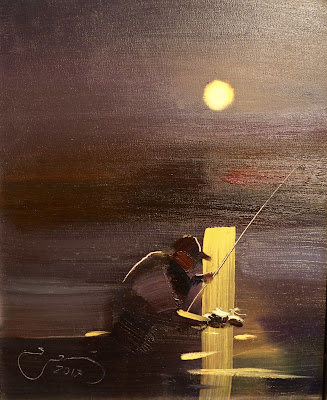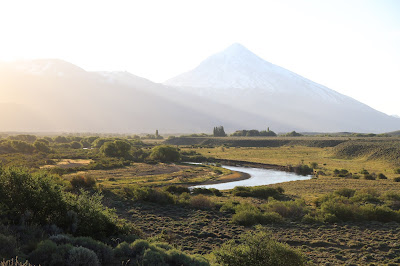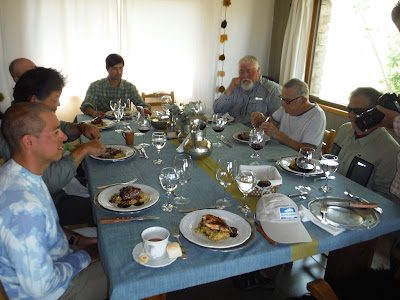In Dec 2019, I went to Patagonia to fly fish the high plateau rivers. This part of Patagonia is an arid land much like the Kamloops region of BC.
Near San Martin de Los Andes, the Lanin volcano dominates the landscape for a hundred kms. This shot is in the Colleccion Georg in San Martin. Lanin is right of centre.
Here is a shot of a cloud that appears to be eating Lanin. As Lanin is 14,000 feet high, how big do you think the cloud is, 50,000 feet? This is a shot of a lifetime, and tells one that to catch the uncatchable you must carry a camera 24 hours a day, which I do.
This superb shot of two girls painted in almost 3-D oil stands out in the gallery. Click on the image to see just how well the camera was able to catch the detail.
Among the many oil paintings is a series on fishing. Here is one.
And who would think to photograph a horse underwater? This is also in the Colleccion Georg. It took this member of the family three years of trying to catch this.
An afternoon shot of the Upper Malleo river with Lanin presiding over afternoon in the background.
Stalking Patagonia rainbows. In the spring pool 30 feet below this rock, swim rainbow trout that are vigilant, being able to spot a fisher dude who mistakenly stands up. Hence, the care taken to stay out of sight.
And a Strike!
And a nice rainbow held up proudly for the camera, by one of the very pleasant guides (name to come).
And with our other quarry, Mr. Brown Trout.
The Three Amigos, with Jim Miller in the middle, from California.
Map of the pools on the Upper Malleo.
Along the many miles of river that we floated, there were rock walls in ochre, as befits their volcanic origin. It crossed my mind that they seemed to be composed of faces and skulls, one on top of the other. Then I would tell myself not to let my imagination run wild in a wild world. But then we would come across another ochre wall and I would see more faces, crowds of them. I got used to being accompanied by my volcanic compadres. After keeping this to myself for several days, while telling myself I was indeed seeing things, I happened to ask my guide if he, too, saw faces in the rocks, assuming he would look at me strangely.
But then, he said, most casually and matter of factly, that the Indigenous peoples of the high steppe lands called the rocks 'the faces' and had been doing so for thousands of years. I felt relieved and more in touch with these people who, like I, at my core, am a person of 'water, land and animals.'
The high steppe in early evening and full moon. You will notice several rock walls in this wide expanse with glimpses of river. This is a shot at an estancia where we stayed in their lodges high above the river valleys. These are also cattle/sheep ranches in their thousands of acres, and, yes, their gauchos still rule the land. The river 'beats' were accessed by the trucks we bumped down gravel roads to find our daily fish. The guides have agreements with the estancia owners. In other words, we met not a soul in our two weeks of fishing.
Nicco of Fly Fishing Last Minute in a wide expanse of river and with his buddy, Mr. Rainbow. The days were typically sunshine and up to 80. For the first time in my life I was loaned - and wore - a 'buff' around my neck. Notice the calm mornings that give way to afternoon winds.
And a closeup of his buddy.
One morning the wind was so high I almost fell into the water a half dozen times. As the wind was slated to get higher in the afternoon, I took this one half day off and wandered the estancia's grounds alone, something I greatly appreciated. Being alone. Many miles of exploration.
A River Map of the Lower Chimchuin River river. Note: click on this or any other image to make it larger.
Horses stampeding among clouds. Photo from Colleccion Georg.
Lunch at the lodge. Note the beef, a regular mid-afternoon treat, before more fishing. Only my plate in the foreground is a chicken dish as I am allergic to beef.
Lunch on the river, very civilized. And more beef, wine and Grolsch.
And even more eating, of dinner at the lodge, along with more wine. We thought we were going to go home fattiea, but it turned out that our days on the rivers were ao long we didn't gain a pound.
In addition to the volcanic 'faces' another common feature is eroded sandstone walls.
One day in a small stream, looking to get a good photo, I handed off my rod with a fish on it to Andreas, one of our guides. Part of his good humour is to make a good shot, and also because it is supposed to be the other way round. And the rest of the humour in this one is the other guides out of the shot hooting and hollering because a guest has given a fish to a guide to catch. What a nice guest. We should ask him to come back. You should ask. I might just come.
One of the constant refrains from the guides as we floated down river was to cast the fly as close as we could get it to the bank. This one is Santos, on the right, telling Chad to put the fly on the bank. You will note heavy brush in the way. The downside on an overhead cast is that it turns over the fly vertically, so there is limited space between branch and water. I normally handle this by casting sidearm, and was promptly told not to do it by my guide one day. I just continued casting sidearm - the fly turns over horizontally, so you get further in under the branches, as in closer to the bank. And the reason we were gently reminded to cast as close to the bank as we could is because this is a dry fly fishery for hatching insects, which usually takes place at the banks were the nymphs climb out of the water, climb the grasses and hatch froom their underwater casings.
And just how close were those fish to the banks? This close.
We were going home to yet another dinner; beef for everyone else and chicken for me.
And the lounge upstairs.
And the golden stairs to the loft.
And after Golden Slumbers, yet another hard day on the water, guide straining to lift up Mr. Brown Trout. It was easily 50 pounds. You do believe me don't you? I thought so.
Our days were like this, vistas of water and sun.
And a photo of me. Do I look happy? You judge. The first two days I do what I normally do, count the fish I catch and promptly release. Well, after 100 returnees, I stopped counting. And this image is at the end of our trip
More images to come.






























